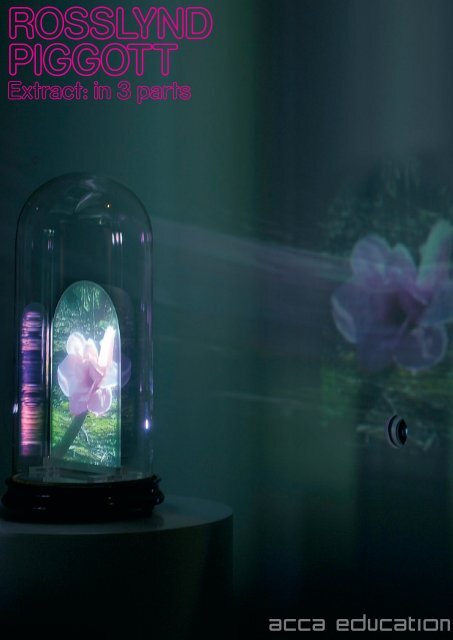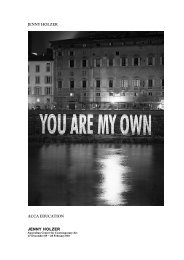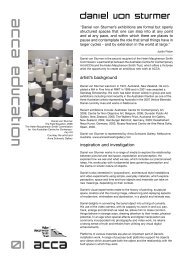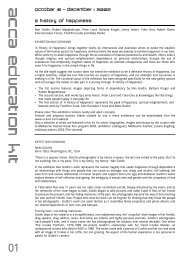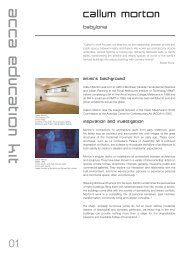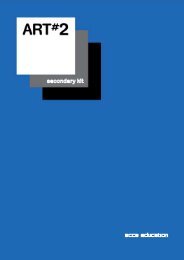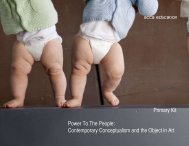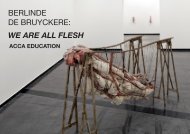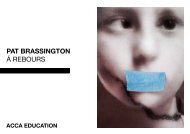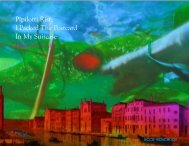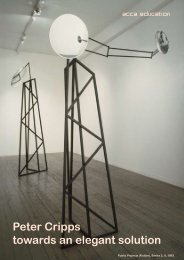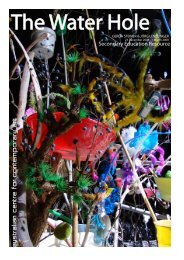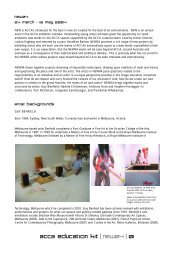acca education
acca education
acca education
- No tags were found...
Create successful ePaper yourself
Turn your PDF publications into a flip-book with our unique Google optimized e-Paper software.
<strong>acca</strong> <strong>education</strong>
THE HELEN MACPHERSON SMITHCOMMISSION (HMSC)Rosslynd PiggottExtract: in 3 partsCommissioning Curator:Juliana EngbergCoordinating Curator:Rebecca CoatesAustralian Centre for Contemporary ArtTHE HELEN MACPHERSON SMITH COMMISSION 20082 August 2008 - 21 September 2008Art Gallery of BallaratSaturday 22 August –Monday 28 September 2009Artist Rosslynd Piggott at her studio in Fitzroy.Photo: Rodger CumminsBIOGRAPHYBorn Melbourne, Victoria, 1958.Currently lives & works in Melbourne, Victoria, Australia.Rosslynd Piggott’s work has received wide acclaim, both nationally and internationally. Since exhibiting for the first timein 1981, Piggott has maintained a very prolific practice, focusing on 3-dimensional works, painting and drawing. Piggott’spractice in installation, video, sculpture and painting has evolved over the past 28 years to reveal sensitive and delicateresponses to natural and domestic environments. The influence of Japanese culture is vivid in both the physical elementsof her work as well as through the arrangement and placement of objects in gallery spaces.In 2008, Rosslynd Piggott was invited to create a major new work for the fourth Helen Macpherson Smith Commission atthe Australian Centre for Contemporary Art. Piggott is the fourth recipient of the Helen Macpherson Smith Commission,a partnership between ACCA and the Helen Macpherson Smith Trust that offers Victorian artists the opportunity to createan ambitious new work of art. For the work, Piggott used film, painting and sculpture, continuing her ongoing explorationof the micro-world of nature, the elements and life itself. In a departure from the usual format of the Commission, Piggottchose to work across ACCA’s three smaller gallery spaces, rather than the Commission Hall.Rosslynd Piggott is represented by Sutton Gallery, Melbourne, Milani Gallery, Brisbane and Gallery 360 Degrees in Tokyo.All images courtesy the artist, Sutton Gallery, Melbourne, Milani Gallery, Brisbane and Gallery 360 Degrees in Tokyo.Further informationThe Rosslynd Piggott exhibition catalogue is now available for sale from ACCA’s bookshop or can be ordered online at www.<strong>acca</strong>online.org.auFront cover:Rosslynd PiggottExtract: in 3 parts, 2008Australian Centre for Contemporary Artdetail<strong>acca</strong> <strong>education</strong>01
Rosslynd PiggottExtract: in 3 parts, 2008Australian Centre for Contemporary ArtdetailCURATORIAL APPROACHWhen Extract: in 3 parts was being developed for ACCA in 2008, Piggott was originally given the opportunity to exhibitin the main commission hall. Given this large space presented challenges for Piggott, with regard to the development ofher ideas, Piggott was then given the opportunity of using the three smaller galleries (a departure from previous HMSCrecipients). Juliana Engberg, the Commissioning Curator of the HMSC and Rosslynd Piggott agreed that the smallerspaces offered greater potential for the artist to realise her ideas.For the HMSC tour to Ballarat, Piggott has again worked with the intimacy of three interlocking spaces. Shown in thePowell Galleries at the Art Gallery of Ballarat, that normally house the Gallery’s Collection of Australian Art from the 1950sand 1960s, the series of three rooms will reflect the interlinking ACCA spaces and subtle colouration shifts, and, will bepainted with a series of subtly shifting greys to accommodate the work.Visitors will also be able to look from the Helen Macpherson Smith Gift, to view previous works by Piggott, selected fromBallarat’s Permanent Collection, on display during the course of the exhibition. At the entrance to the exhibition, Piggottwill also work with members of Ballarat’s bonsai society to present a series of bonsai plant displays that will change duringthe course of the show.In the first gallery, significant construction has be undertaken for the installation of the magnolia projections. Gallery twodisplays the gift component, a palladium painting, a mirror work, shelf and mirrored vessel. The final gallery houses anight sea projection filmed at Stradbroke Island, alongside a suspended black lacquered box, that holds an illuminateddiamond.<strong>acca</strong> <strong>education</strong> 03
LIST OF WORKSRosslynd PiggottExtract: in 3 parts, 2008Australian Centre for Contemporary ArtdetailExtract: in 3 parts, 20081ST GALLERYDVD projection x 2Victorian glass bell jars, glass and wooden base x 2Sandblasted glass screen x 2Perspex stands x 2Cardboard and ply plinths finished with 2-pack paint x 2Tasmanian ash wooden stand, glass top2ND GALLERYHand slumped mirrorOil and palladium leaf on linenRhodium-plated fine silver parabolic diskMDF shelf finished with 2-packDouble walled & mirrored glass3RD GALLERYDVD projectionMDF matt painted stepsMDF wooden box finished with automotive high gloss paintOptic fibre and electrical parts4mm diamond, platinum setting, 18 carat nickel white gold pin painted in black gouache<strong>acca</strong> <strong>education</strong> 04
LEARNING ACTIVITESVCE Art - Unit 1, Outcome 2: Art and Society>Analyse the artwork of Rosslynd Piggott using a cultural interpretive framework. How can you see the influence ofJapanese culture in her work? Compare Piggott’s work to the work of other artists who are influenced by cultures otherthan their own. Look at Picasso’s interest in African Culture and Gaughin’s interest in Tahitian culture.>Piggott has repeatedly created works that are circular which is symbolic of cycles of life, death and reincarnation.Compare Piggott’s Glass Mirror , Palladium Painting and Rhodium Disk? to the work of Italian Renaissance painterGiotto and consider the ways artists from different eras have portrayed spirituality and religious themes.>Piggott’s film work, depicting the ocean on Stradbroke Island has deliberately been slowed to one tenth of its originalspeed. Piggott has deliberately created an environment that is immersive and meditative, forcing the viewer to slow downand reflect on nature and questions of existence. Consider how Piggott, as a contemporary artist, has drawn from theRomantic artists of the 18th and 19th century in her contemplation of nature and the metaphysical realm.VCE ART - Unit 2 Outcome 2: Art and the individual>Piggott is inspired by nature and her experience of overseas travel in her work. Her work is also inspired by her personalexperiences and an inquiry into the meaning of existence. Consider the way your personal experiences have shaped thekind of art you make and would like to make. Consider the role of the artist. Do you think it’s the role of the artist to inspirean audience to consider greater questions about being and existence?VCE ART - Unit 3, Outcome 2: Interpreting Art>Analyse Piggott’s work using ‘symbolism’ as an interpretive framework.>Consider the way Piggott uses circles as a symbol, which relate to the Buddhist belief in cycles of life, death andreincarnation. Her recurrent use of flowers, specifically the magnolia, is also symbolic of the transience of life. Discusssymbolism in two of her works.>Look at Piggott’s of the ocean from Stradbroke Island. Piggott has deliberately slowed the speed of this film work toinvoke meditation and reflection on existential questions. Consider the way in which Piggott uses modern technology tomake the viewer consider age-old questions about ‘being’ and existence.>Piggott has made many works using glass. She is interested in the elements and how glass is a process of dramatictransformation, from liquid to a solid form, after being heated in extreme temperatures and then cooled. Analyse some ofPiggott’s glass works using a formal interpretive framework. Discuss the materials and techniques, shape, form, textureand colour and how these are significant to the meaning of her works.>Consider the historical depictions of flowers in art. Look at the work of Margaret Preston and compare these works toPiggott’s depictions of flowers in art. Compare materials, techniques and themes in the work of past artists working withthis theme and the way in which Piggott both presents and displays this aspect of her work.VCE Studio Arts - Unit 1, Outcome 3: Interpretation of art ideas and use of materials and techniques>Rosslynd Piggott uses Paladium on linen in her works to evoke self reflection and comment on the elusive and theintangible aspects of nature. Research artists from other eras such as renaissance and medieval artists who worked withgold and silver leaf. Consider the significance of these materials and look at the different techniques they used in theapplication of this medium.VCE Studio Arts - Unit 2, Outcome , Design exploration and concepts>Rosslynd Piggott has used images of flowers by filming these and projecting them in a gallery space. Her projectedworks show movement to reflect the movement in nature.>Create a series of photographs, paintings or lightweight sculptures that capture movement in nature.You may like to photograph cherry blossoms blowing in the wind or create paper floral sculptures that have movingelements or watercolour paintings of clouds.VCE Studio Arts - Unit 4, Outcome 3: Art industry contexts>Write about the preparation of the gallery space for Rosslynd Piggott’s exhibition. Looking at the materials she has used,what issues do you think would need to be considered in the preparation of a gallery space for this exhibition? Considerissues such as controlling humidity in the space, the arrangement of artworks and the physical construction of the space.<strong>acca</strong> <strong>education</strong> 06
VELS LEARNING ACTIVITIESRosslynd PiggottExtract: in 3 parts, 2008Australian Centre for Contemporary Artdetail>Piggott draws inspiration in her work from Japanese culture. Create a series of artworks inspired by Japanese Culture.Include the use of gold paint in your artwork and imagery from Japanese artworks you have seen, for example, cherryblossoms, birds, the moon, etc.(Visual Art, Creating and making: Level 6)>Piggot uses palladium (similar to silver or gold leaf) on the surface of some of her works. Look at artists historically suchas Gustave Klimt, Lucio Fontana and artists of the Renaissance era who used gold and silver leaf in their artworks. Whatwas the significance of gold and silver in the work of these artists and why was it used by them?(Level 5: Historical Knowledge and Understanding or Level 5: Visual Art, Exploring and responding)>Piggott’s artworks have been described as delicate and ephemeral. Create an artwork influenced by nature using lightweightmaterials that reflects the intangibility of nature. You may like to use collage, watercolour or gauche on paper todepict an image from nature or inspired by nature.(Visual Art, Creating and making: Level 5)>Consider Piggott’s interest in questions of existence. Write a piece on scientific theories of human evolution; think abouthuman ancestors such as apes and the ‘big bang’ theory. Do you believe that science alone can answer these questions?(Science knowledge and understanding: Level 3)>Piggott is interested in the notion of endless space in her studies of clouds. She is also interested in Buddhist questionsof existence. Write a creative writing piece on your own thoughts about existence. Why are we here? Where did we comefrom, and where are we going?(English: Level 3, Writing)>Take a series of photographs of clouds and from these make a series of abstract paintings.>Piggott uses Asian symbolism in her works, for example, Buddhism and the circle as symbol of life, death and reincarnation.Consider the way symbols reflect the cultural identity of certain countries. Write on the symbols associated withAustralian Identity. What do they represent and are they an accurate reflection of Australian Culture/spirituality.(History: Level 5, Pathway or English: Level 5, Writing)>Piggott likens the process of her painting to meditation. Create an abstract painting without planning in any way. Try tomake it a meditative piece, as an expression of your own subconscious.(Visual Art: Level 4, Creating and making)<strong>acca</strong> <strong>education</strong> 07
COMMENTARIES“I’m interested in the blossom because of my interest inJapanese Culture….It’s the appearance of life after a longwinter, and a symbol of brief beauty and perfection…likethe blossom, human life disappears, and that’s somethingwe need to accept.”Rosslynd Piggott“In our bodies…we’re not separate from the endlessness.Maybe our human ego thinks that we are, but we’reactually not, we’re actually just another form of it. Andthat’s what interests me about the Buddhist thinking aswell, that life, our life, and energy whatever-continues. I’mnot completely sure on the technicalities of reincarnationbut I do believe that energy is continuous.”Rosslynd Piggott - Interview by Miles Du Heaume for opening of “Endlessblossom space” exhibition, 16th April, 2004.“Piggott’s style is slow and deliberate, often using naturalforms and systems as a starting point for painterlymeditations. Her practice is influenced by JapaneseCulture, her delicate and airy images have been said tooffer the merest wisp of the ungraspable”Sutton Gallery: artist profile,http://www.suttongallery.com.au/artists/artistprofile.php?id=3“I have often dealt with the notion of endless space in mypaintings…. deep black circles and blurred white windowsbecome spaces into voids and emptiness- as understoodin Buddhist context- the inherent non-existence of things.These spaces then picture this interface between ourhumanness and the big space/home where we come andgo.”Rosslynd Piggott, http://www.holmesacourtgallery.com.au/collection/artist-profile.cfm?artist_id=82Rosslynd PiggottExtract: in 3 parts, 2008Australian Centre for Contemporary Artdetail“Piggott’s objects and environments seek to engage inessential human emotions – desire, memory, anxiety,longing. Her refined aesthetic and poetic sensibilitiescombine an acute attention to detail and an innatesense for the inherent material properties and intangiblemetaphorical potential of the things around us.”Timothy Potts, Director, NGV<strong>acca</strong> <strong>education</strong> 08
FURTHER RESEARCHAll images:Rosslynd PiggottExtract: in 3 parts, 2008Australian Centre for Contemporary Artdetailhttp://http://www.suttongallery.com.auhttp://www.360.co.jp/http://www.milanigallery.com.au/http://www.ngv.vic.gov.au<strong>acca</strong> <strong>education</strong> 09


